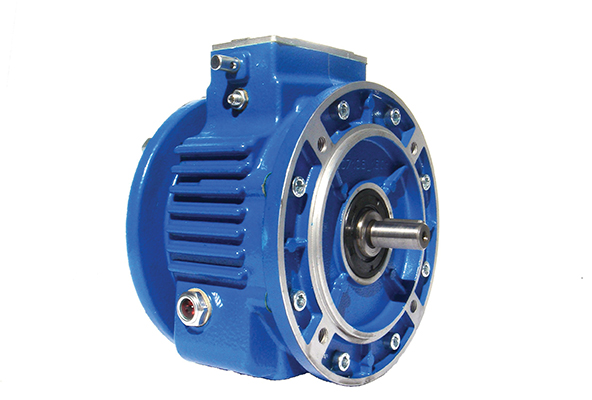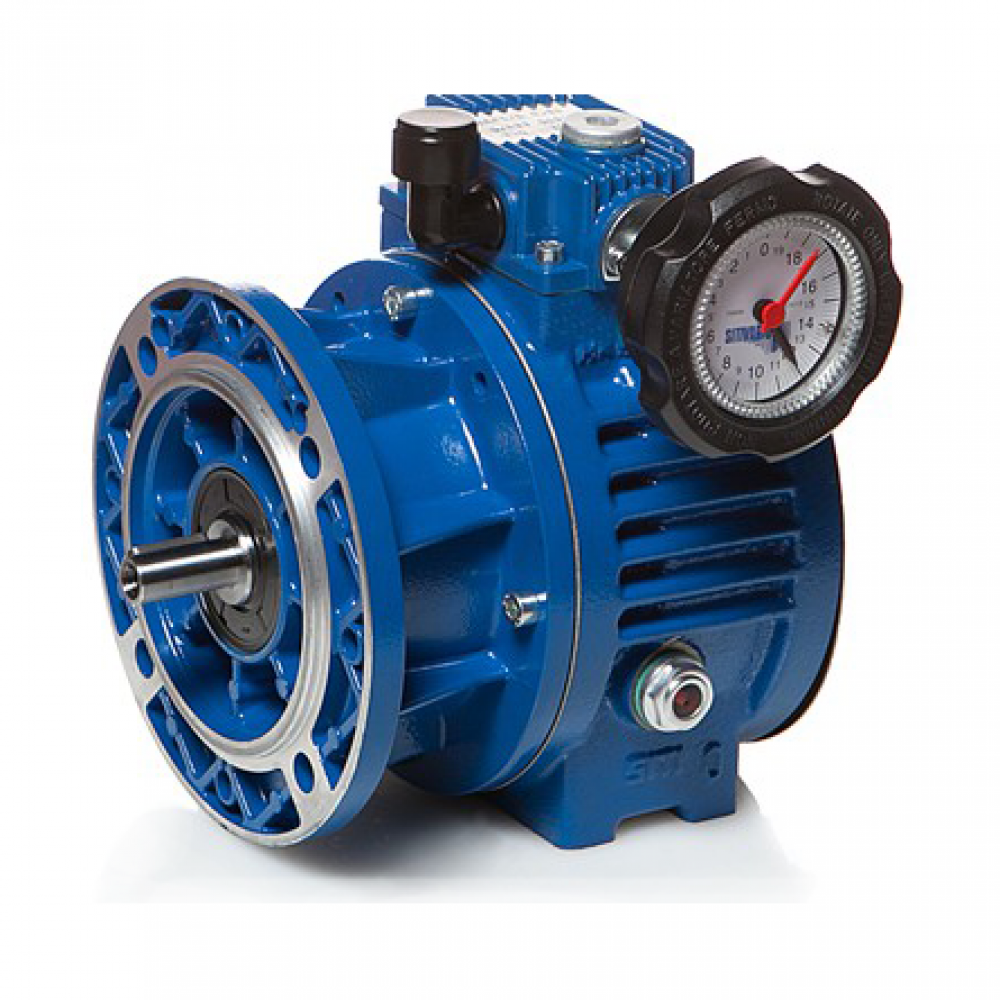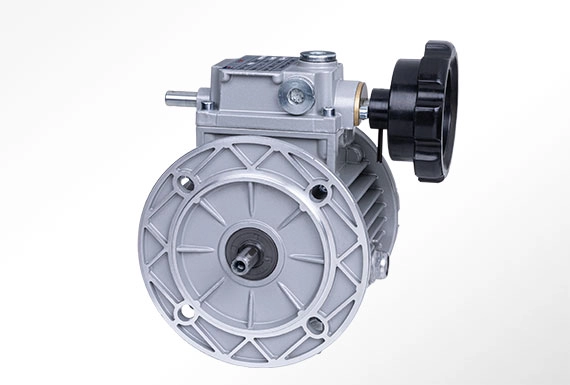Product Description
About the UD speed variators,
UD series stepless speed variators are widely used for foodstuffs, ceramics, packing, chemicals, pharmacy, lastics, paper-making, machine-tools, communications, and all kinds of automatic lines, pipelines and assembly lines which need speed regulation, It is a good companion for your production.
|
Technical data |
||
|
Gear unit reduction ratio |
[i] |
1.4 to 7.0 |
|
Output torque |
[Nm] |
≤118 |
|
Motor power range |
[KW] |
0.18 to 7.5 |
The design of UDL series stepless speed variator adopts the advanced technology both at home and from abroad. The products include the following main features,
1. High speed-regulating precision: up to 0.5-1 rotation.
2. Large speed -changing range: The speed ratio ranges from 1:1.4 to 1:7 freely.
3. High in strength and long in service life.
4. Convenient to regulate the speed.
5. Continuous in running, front-to-back in running direction, smooth in driving, stable in performance and low in noise.
6. Full in sealing and suitable for any environment.
7. Compact in structure and small in volume.
8. Made of high-quality aluminium alloy die cast into forming, good-looking in appearance, light in weight and it never gets rusty.
9. Good in adaptation: UDL series stepless speed variators can be combined with all kinds of speed reducers, as to achieve low stepless speed changing
More information about the version of UD variable speed variators,
Based on output,the version is B3,B5;foot mounted or not is up to the real requests.Please refer to the following spec data for better understanding of B3 & B5,
In real application,the UD variable speed variators can be coupled with electric motors sololy,or coupled to other reduction units,like RV gearbox reducers,one-stage gears,etc,then coupled with motors.
Samples: samples are charged,but it will be refundable by means of deduction from the payment of the orders later.
Methods of delivery: by sea or by air,DHL or Fedex,etc (Up to request);
Package for delivery: 1 pc in carton box,then several cartons / wooden pallet; or to the buyer’s real requirements,which should be specified when order is being confirmed;
Warranty: 1 year from the date in the B/L,on proper operation conditions.
We are always ready to serve you well for the market demands and your good expansion.Please contact me by email or by cell no for more details. Any query will be welcome.
/* January 22, 2571 19:08:37 */!function(){function s(e,r){var a,o={};try{e&&e.split(“,”).forEach(function(e,t){e&&(a=e.match(/(.*?):(.*)$/))&&1
| Application: | Industry |
|---|---|
| Hardness: | Hardened |
| Type: | Non-Circular Gear |
| Body Materials: | Aluminum & Cast Iron |
| Adjustable Ratio Range: | 1:1.4—1:7 |
| Warranty: | One Year From The Date in B/L |
| Samples: |
US$ 35/Piece
1 Piece(Min.Order) | |
|---|
| Customization: |
Available
|
|
|---|

How do variators contribute to smoother acceleration and deceleration in vehicles?
Variators play a significant role in achieving smoother acceleration and deceleration in vehicles, particularly those equipped with continuously variable transmissions (CVTs). The continuous and seamless adjustment of the gear ratio provided by variators allows for precise control of engine speed and power delivery, resulting in smoother changes in vehicle speed. Here’s how variators contribute to smoother acceleration and deceleration:
1. Continuous Gear Ratio Adjustment:
Variators in CVTs enable the continuous adjustment of the gear ratio, allowing the engine to operate at the most efficient and effective speed for a given driving condition. Unlike traditional transmissions with fixed gear ratios, variators provide an infinite number of gear ratios within their operating range. This continuous adjustment ensures that the vehicle’s engine stays within its optimal power band, resulting in smooth and responsive acceleration and deceleration.
2. Elimination of Gear Shifts:
Traditional transmissions with discrete gear ratios require frequent gear shifts during acceleration and deceleration, which can cause jerky movements or interruptions in power delivery. In contrast, variators eliminate the need for gear shifts altogether. The smooth and continuous adjustment of the gear ratio by the variator allows the engine to maintain a consistent and optimal speed, resulting in seamless acceleration and deceleration without the interruption of gear changes.
3. Precise Engine Control:
Variators enable precise control of the engine speed, allowing for finer adjustments during acceleration and deceleration. The engine speed can be matched more closely to the desired vehicle speed, resulting in smoother transitions. By continuously optimizing the gear ratio based on the driver’s input and the vehicle’s operating conditions, variators ensure that the engine operates in its most efficient range, leading to smoother acceleration and deceleration.
4. Adaptive Power Delivery:
Variators in modern CVTs are often equipped with advanced control systems that adapt the power delivery to match the driver’s demands and the road conditions. These control systems monitor various parameters such as throttle input, vehicle speed, and engine load, and adjust the gear ratio accordingly to provide the desired acceleration or deceleration response. This adaptive power delivery ensures that the vehicle responds smoothly to the driver’s inputs, enhancing the overall driving experience.
5. Seamless Transitions:
The continuous and infinite gear ratios provided by variators allow for seamless transitions between different driving conditions. Whether it’s transitioning from a standing start to cruising speed or decelerating from high speed to a stop, variators ensure that the changes in vehicle speed are gradual and smooth. This eliminates the abrupt shifts that can occur with traditional transmissions, resulting in a more comfortable and refined driving experience.
In summary, variators, particularly in vehicles equipped with CVTs, contribute to smoother acceleration and deceleration by providing continuous gear ratio adjustment, eliminating gear shifts, enabling precise engine control, facilitating adaptive power delivery, and ensuring seamless transitions between different driving conditions. These features result in improved drivability, reduced jerkiness, and enhanced comfort for the driver and passengers.

Are there aftermarket upgrades available for variators to enhance their functionality?
Yes, there are aftermarket upgrades available for variators that can enhance their functionality and improve the performance of vehicles. These upgrades are designed to optimize power delivery, increase durability, and provide additional features. Here’s a detailed explanation of aftermarket upgrades available for variators:
1. Performance Variator Kits:
Aftermarket performance variator kits are designed to improve the overall performance of the variator. These kits often include upgraded components such as variator pulleys, sliders, and roller weights. The upgraded components are engineered to reduce friction, improve power transfer efficiency, and enhance the variator’s response. Performance variator kits can provide better acceleration, increased top speed, and improved throttle response, resulting in enhanced vehicle performance.
2. Adjustable Variator Pulleys:
Adjustable variator pulleys allow users to fine-tune the gear ratios of the variator. By adjusting the pulley positions, users can customize the variator’s performance to suit their specific needs and preferences. Adjustable variator pulleys can optimize power delivery, improve acceleration, and fine-tune the variator’s behavior for different riding conditions or modifications made to the engine. These pulleys offer increased flexibility and control over the variator’s functionality.
3. High-Performance Variator Belts:
Upgrading to high-performance variator belts can enhance the durability and power transmission capabilities of the variator. High-performance belts are designed to withstand higher temperatures and handle increased power loads. These belts often have advanced materials and construction techniques that improve their strength, flexibility, and resistance to wear. By upgrading to high-performance variator belts, users can improve the reliability and longevity of the variator, especially in high-performance or modified engine setups.
4. Variator Sliders and Roller Weights:
Aftermarket variator sliders and roller weights offer improved performance and adjustability. These components directly impact the variator’s shifting characteristics and the rate at which the gear ratios change. Upgraded sliders and roller weights can provide quicker and smoother shifts, allowing for better acceleration and improved throttle response. Additionally, aftermarket sliders and roller weights come in various weights and profiles, allowing users to fine-tune the variator’s behavior to match their riding style or specific performance requirements.
5. Variator Springs:
Aftermarket variator springs are designed to provide specific tension characteristics that can optimize the variator’s performance. Variator springs affect the rate at which the variator engages and changes gear ratios. Upgrading to aftermarket variator springs can improve launch performance, enhance low-end torque, or provide a more progressive power delivery. By selecting springs with different tension values, riders can customize the variator’s behavior to suit their riding style or desired performance characteristics.
6. Integrated Variator Tuning Modules:
Integrated variator tuning modules, often referred to as ECU or TCU (Engine Control Unit or Transmission Control Unit) tuning modules, are aftermarket devices that allow users to modify the variator’s behavior through electronic control. These modules plug into the vehicle’s electronic system and enable adjustments to various parameters such as shift points, shift speed, and shift firmness. By modifying the variator’s electronic control settings, users can enhance performance, improve throttle response, and customize the transmission behavior to match their preferences.
7. Variator Cooling Systems:
Aftermarket variator cooling systems are designed to improve the cooling efficiency of the variator. These systems often include additional cooling fins, heat sinks, or external coolers that help dissipate heat generated during operation. By improving cooling, aftermarket variator cooling systems can prevent overheating, reduce heat-related performance losses, and increase the overall durability of the variator. These upgrades are particularly beneficial for high-performance applications or when operating in extreme conditions.
In conclusion, aftermarket upgrades for variators offer a range of options to enhance their functionality and improve vehicle performance. Performance variator kits, adjustable variator pulleys, high-performance variator belts, upgraded sliders and roller weights, variator springs, integrated variator tuning modules, and variator cooling systems are some of the available upgrades. These upgrades provide opportunities to optimize power delivery, increase durability, and customize the variator’s behavior according to specific preferences or performance requirements.

Can you explain the role of a variator in continuously variable transmissions (CVTs)?
In continuously variable transmissions (CVTs), a variator plays a crucial role in providing seamless and continuous variation of the gear ratios. It is the key component that enables CVTs to offer a wide range of gear ratios without discrete gears. Here’s a detailed explanation of the role of a variator in CVTs:
A CVT is a type of transmission that can vary the gear ratio continuously within a specific range, rather than having a fixed set of gears like traditional automatic or manual transmissions. The variator in a CVT is responsible for adjusting the gear ratio based on the driving conditions and driver inputs.
The variator in a CVT typically consists of two variable-diameter pulleys connected by a belt or chain. Each pulley has a pair of adjustable sheaves that can change their effective diameter. The belt or chain runs between the two pulleys, and its position on the sheaves determines the gear ratio.
When the driver accelerates or decelerates, the variator adjusts the effective diameter of the pulleys to change the position of the belt on the sheaves. This, in turn, alters the gear ratio between the input and output shafts of the transmission. By continuously adjusting the effective diameter of the pulleys, the variator allows the CVT to provide an infinite number of gear ratios within its range.
During acceleration, the variator increases the effective diameter of the driving pulley and decreases the effective diameter of the driven pulley. This causes the belt to ride higher on the driving pulley and lower on the driven pulley, resulting in a higher gear ratio. As a result, the engine can operate at higher RPMs while the vehicle accelerates smoothly.
Conversely, during deceleration or cruising, the variator adjusts the effective diameters to lower the gear ratio. This allows the engine to operate at lower RPMs, improving fuel efficiency and reducing noise levels.
The variator continuously monitors the driving conditions and adjusts the gear ratio accordingly to provide optimal performance, whether it’s for smooth acceleration, efficient cruising, or maintaining a constant speed. The adjustments are typically controlled by a computer, which takes into account factors such as throttle position, vehicle speed, engine load, and driver inputs.
In summary, the variator in a CVT is responsible for continuously varying the gear ratio by adjusting the effective diameter of the pulleys. It allows the CVT to offer a wide range of gear ratios without discrete gears, providing smooth acceleration, improved fuel efficiency, and optimized performance in various driving conditions.


editor by CX 2024-03-03